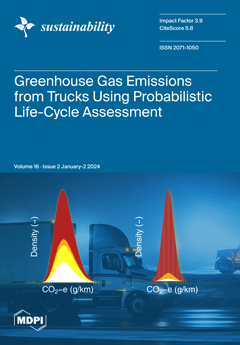Vietnam is the world’s largest cement exporter. In 2022, it produced 118 Mtpa cement while emitting 109 Mtpa cement-related CO
2, equal to 33% of Vietnam’s total CO
2 emission. As Vietnam has pledged to achieve net zero by 2050, unabated cement-related CO
[...] Read more.
Vietnam is the world’s largest cement exporter. In 2022, it produced 118 Mtpa cement while emitting 109 Mtpa cement-related CO
2, equal to 33% of Vietnam’s total CO
2 emission. As Vietnam has pledged to achieve net zero by 2050, unabated cement-related CO
2 emission must be drastically reduced in the future. This paper investigates the contribution of carbon capture and storage (CCS) to decarbonizing Vietnam’s cement industry to make cement production cleaner and more sustainable. A first-of-a-kind CO
2 source-sink mapping exercise was conducted to map 68 cement plants to subsurface sinks, including oil and gas reservoirs and saline aquifers, using four CCS field development concepts. The results have identified four first-mover CCS projects where CO
2 emissions from 27 cement plants are mapped to nearby offshore subsurface CO
2 sinks. Two of these projects are located in Vietnam-north, one in Vietnam-central, and one in Vietnam-south. In the Vietnam-south CCS project, CO
2 emission from the Kien Giang province is transported and stored in the offshore Block B gas field. In the other three CCS projects, CO
2 emission is transported to nearshore saline aquifers in the Song Hong Basin. At a CO
2 capture rate of 90%, these four projects will mitigate 50 Mtpa CO
2, which is 46% of cement-related CO
2 emission or 15% of total CO
2 emission from Vietnam, thus making Vietnam’s cement production cleaner and more sustainable. Future research should focus on subsurface characterization of saline aquifers in the Song Hong Basin. The methodology developed in this study is usable in other cement-producing countries with significant CO
2 sinks in the nearshore continental shelf.
Full article





